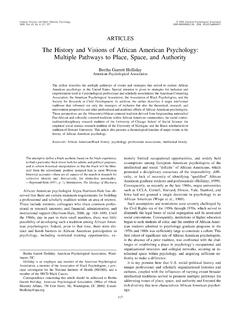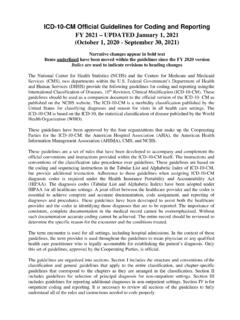Transcription of The Effects of Single-Sex Compared With Coeducational ...
1 The Effects of Single-Sex Compared With Coeducational Schooling onStudents Performance and Attitudes: A Meta-AnalysisErin PahlkeWhitman CollegeJanet Shibley Hyde and Carlie M. AllisonUniversity of Wisconsin MadisonProponents of Single-Sex (SS) education believe that separating boys and girls, by classrooms or schools,increases students achievement and academic interest. In this article, we use meta-analysis to analyzestudies that have tested the Effects on students of SS Compared with Coeducational (CE) schooling. Wemeta-analyzed data from 184 studies, representing the testing of million students in Grades K 12from 21 nations, for multiple outcomes ( , mathematics performance, mathematics attitudes, scienceperformance, educational aspirations, self-concept, gender stereotyping).
2 To address concerns about thequality of research designs, we categorized studies as uncontrolled (no controls for selection Effects , norandom assignment) or controlled (random assignment or controls for selection Effects ). Based onmixed- Effects analyses, uncontrolled studies showed some modest advantages for Single-Sex schooling,for both girls and boys, for outcomes such as mathematics performance but not for science studies, however, showed only trivial differences between students in SS versus CE, formathematics performance (g for girls, for boys) and science performance (g for girls, for boys), and in some cases showed small differences favoring CE schooling ( , for girls educational aspirations,g ).
3 Separate analyses of studies yielded similar findings ( , formathematics performanceg for girls and for boys). Results from the highest quality studies,then, do not support the view that SS schooling provides benefits Compared with CE schooling. Claimsthat SS schooling is particularly effective for ethnic minority boys could not be tested due to the lackof controlled studies on this : Single-Sex , Coeducational , performance, attitudes, meta-analysisSupplemental materials: decry the poor performance of American children onstandard tests of mathematics and science knowledge, by compar-ison with their peers from other nations (Else-Quest, Hyde, &Linn, 2010; OECD, 2010).
4 This poor performance has led to callsfor changes in public school education. One solution that has beenproposed is Single-Sex classrooms or schools (Gurian, Henley, &Trueman, 2001; James, 2009; Sax, 2005). Public schools acrossthe country have adopted this potential solution; on the basis offollow-up analyses of data from the Office of Civil Rights 2010data collection, the Feminist Majority Foundation (2011) estimatedthat thousands of public schools offered Single-Sex academicclasses during the 2009 2010 school year. Attempts to synthesizeresearch on the Effects of Single-Sex schooling have been contra-dictory or equivocal ( , Mael, Alonso, Gibson, Rogers, & Smith,2005; Morse, 1998), perhaps because none of the reports used therigorous method of meta-analysis to synthesize the , since those reports appeared, and with the approval offederal funding for Single-Sex programs in public schoolsbeginning in 2006, much more research has appeared.
5 The purposeof the research reported here was to use meta-analysis to synthe-size the results of research comparing Single-Sex with coeduca-tional schooling in regard to multiple student outcomes, includingmathematics and science performance and academic performancein other areas, as well as motivation, interest, and attitudes. Thou-sands of children attend Single-Sex schools each day, and, in thecase of public schools, millions of taxpayer dollars are being spenton Single-Sex schooling. It is essential that scientists, educators,and policy makers know whether Single-Sex schooling is a moreeffective learning environment for students, Compared with coed-ucational FrameworksIn designing the current study, we set out to conduct a theory-driven (as opposed to a theory-testing) meta-analysis.
6 That is, weused theory to inform the research questions and approaches,including moderator analyses. Three theoretical approaches frompsychology were particularly relevant to this meta-analysis, as theycan be used to understand why Single-Sex schooling might orThis article was published Online First February 3, Pahlke, Department of Psychology, Whitman College; Janet Shib-ley Hyde and Carlie M. Allison, Department of Psychology, University ofWisconsin research was supported by Grant DRL 1138114 from the NationalScience Foundation. Any opinions expressed are those of the authors andnot the National Science Foundation.
7 The authors thank Larry Hedges forconsultation during the concerning this article should be addressed to ErinPahlke, Department of Psychology, Whitman College, Walla Walla, WA99362. E-mail: Bulletin 2014 American psychological Association2014, Vol. 140, No. 4, 1042 10720033-2909/14/$ DOI: not be effective in improving student outcomes: expectancy-value theory, developmental intergroup theory, and views of largebiological gender differences in , Eccles and colleagues expectancy-value theoreticalmodel was originally proposed to explain the gender gap in math-ematics performance as well as the underrepresentation of womenin careers in science and engineering ( , Eccles, 1994; Jacobs,Davis-Kean, Bleeker, Eccles, & Malanchuk, 2005.)
8 Meece, Eccles-Parsons, Kaczala, Goff, & Futterman, 1982). This model can alsobe applied to the question of how classroom composition mayinfluence student outcomes. According to the model, two catego-ries of factors contribute to an individual s decision to pursue achallenge such as taking an advanced mathematics course in highschool or embarking on a PhD in physics: (a) expectations forsuccess and (b) values. With regard to the first factor, people donot undertake a challenge unless they have some expectation ofsuccess. According to the expectancy-value theoretical model,expectations of success are shaped by the person s aptitude, rele-vant past events such as grades in the subject and scores onstandardized tests, socializers attitudes and expectations, the per-son s interpretations of and attributions for these events, and theperson s self-concept of his or her ability.
9 Perceptions of the valueof the task ( , taking the challenging mathematics course) areshaped by the cultural milieu ( , gender segregation of occupa-tions, cultural stereotypes about the subject matter, teachers atti-tudes) and the person s short-term and long-term goals ( ,becoming an elementary school teacher and thinking one does notneed advanced mathematics or becoming a civil engineer andknowing that one does). The theory has received abundant empir-ical support ( , Eccles, 1994; Frome & Eccles, 1998). For ourpurposes, it provides a clear model for why Single-Sex schoolingmay influence girls achievement and interest in mathematics andscience.
10 School and classroom environments are themselves cul-tural milieus. A classroom environment based on beliefs in sub-stantial, biologically based gender differences that drive somesingle-sex programs (reviewed below) may have an adverse im-pact on girls and women entering science, technology, engineer-ing, and mathematics (STEM) careers. The very gender segrega-tion of the classroom may highlight the gender segregation of adultoccupations, increasing girls belief that they do not belong inSTEM occupations in which few women are found. In contrast, the girl power views that drive other Single-Sex programs (reviewedbelow) may have a positive impact on girls and women by in-creasing expectations for theory also provides guidance as to the out-comes that should be considered if the goal is to maximize stu-dents achievement.














